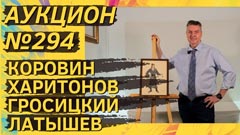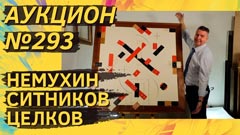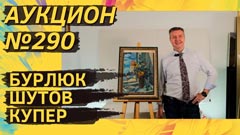
MASTERPIECES
MIKHNOV-VOITENKO Evgeny Grigorievich (1932–1988) Composition. 1960. Oil on cardboard. 105 × 205
“Here's to twenty years of no-exhibition work!” This was the toast to Evgeny Mikhnov-Voitenko in November 1976, after the exhibition of nonconformists at the Ordzhonikidze Culture Center. Colleagues understood that by objective, unbiased assessment they were drinking to the health of one of the main innovators of abstract art. But formally — yes, it was indeed the first exhibition of Mikhnov. And the artist had to be firmly persuaded. Mikhnov's first solo exhibition in Leningrad was held even later — in 1978. And in Moscow — only in 1982. Artist just turned 50. It would seem, the heyday. But life, alas, has been lived — Mikhnov had only 6 years to live after that. He died in 1988 — in the midst of perestroika, when everything was bursting at the seams. A perfect time to be long forgotten and fall off the ranks.
In general, this is a very Russian story: at the same time it is bright, sad, dashing and unsettled. One of the most brilliant representatives of post-war unofficial art lived in a smoky communal apartment and worked at an arts and crafts factory. Often sat without orders. He drank heavily. And all the time he was painting something in his little room, smearing it, spraying it, setting it on fire. The true scale of his talent was understood only by a narrow circle of understanding and sensitive people. Rukhin used to bring Norton Dodge to him. Poet Leonid Aronzon dedicated poems to him. The artist was not deprived of the luxury of human communication. But at the same time, Mikhnov fully drank the cup of misunderstanding, lack of recognition, depressions, monstrous lack of money and failures. The artist received the final blow of fate after his death, when some of his works disappeared in an unknown direction. As if by an evil stroke of fate. After all, this is what he feared the most. Even though Mikhnov himself often said that in art the game is not for winning, but for the process. But still, his last words were: “Save my paintings!”
When the time came to gather the stones, it turned out that the whereabouts of a number of important paintings were unknown; traces of a number of masterpieces were lost abroad. A professional documentary film made about Mikhnov in 1976 had disappeared. Many amateur films and tape-recorded conversations with him were lost after his death. But the memories of his widow and friends have been preserved. And, most importantly, the paintings and hundreds of drawings remained.
Eventually the story found a happy ending. Thanks to the efforts of people who loved, appreciated and understood Mikhnov-Voitenko, in the 2000s his heritage was presented in the best exhibition halls. And it caused a sensation. People saw that since the 1950s, in Leningrad, a true innovator of post-war abstraction, not of national, but of world level, was working.
And today we have a huge rarity in front of us! An event! This may be the last large-scale, museum-level painting by Mikhnov-Voitenko available on the market.
This two-meter composition from 1960 has participated in all important museum exhibitions. It has been published in several catalogs, including an important album by Aslan Chekhoev published for the 2010 exhibition. These books, by the way, we will present to the buyer.
The artist's widow, Evgenia Sorokina, recalls that in the 1960s Mikhnov did not sign or date paintings on purpose, not wanting to introduce something alien into the world of a painting. Nor has the title survived, although it can be assumed that initially it might have been. After all, Mikhnov himself was against his things being called abstractions. He referred to them as “concretions” (from the word “concreteness”), developing the idea that abstraction is the peak and ultimate state of realism. Mikhnov emphasized that his compositions are eventful and concrete. That is why he gave many of them figurative titles: “Queue”, “Metamorphosis”, “Carnival”, etc. But this time the artist has left us with a mystery. The task of determining the figurative basis will fall on the viewer. However, from the recordings of interviews with the artist we can extract many clues — from that cloud of ideas, which occupied him. Thus, in Mikhnov's paintings, one should first of all look for compressed music, concentrated reality, a kaleidoscope of worlds, and human “candlehood”. “Candlehood” — from the words “candle” and “glow” — is also a term invented by Mikhnov and his basic philosophical credo. Therefore, the flashes of flame and fluttering light that the viewer will see in our picture are not a random illusion, but part of the idea.
PYATNITSKY Vladimir Pavlovich (1938–1978) In the city. Mid 1970s. Oil on canvas. 60 × 48
Another great rarity. Vladimir Pyatnitsky is one of the legends of unofficial art. Many consider him a symbol of true nonconformism, who, with all the possibilities, deliberately refused to participate in the market, and even chose the path of desperate self-destruction. Alas, all this has a downside. Despite his famous name, very few of Pyatnitsky's paintings have survived. The public hardly knows them. For many years, this is the first time a complete canvas by Pyatnitsky appears on the national auction market. The painting “In the city” was brought from Germany, from the collection of Pyatnitsky's friend, the sculptor-ceramist Pavel Zamihovsky-Frumkin.
Pyatnitsky, who died at 40 as a drug addict, was in his youth a talented student of the Chemistry Department of Moscow State University, an athlete, a man of many talents, a connoisseur of poetry (especially Mayakovsky) and a great intellectual. Suddenly, at the institute, he realized that he wanted to tie his fate with the arts, left his academic career and went into creativity. One of his sources of inspiration were Goya's Caprichos, including the famous etching “The Sleep of Reason Produces Monsters”. Pyatnitsky's drawings were soon populated by strange characters, freaks, and participants in absurd scenes. His graphics and paintings remain largely non-commercial — they lack the coziness, decorativeness, and “beauty” that bribe the mass viewer. Pyatnitsky's subjects are often harsh, surreal, and incomprehensible to the average person.
It is all the more paradoxical that Pyatnitsky co-authored one of the most popular unofficial comics, “Jolly Fellows”. Jokes about Russian writers, written in Kharms's parody style, became bestsellers in “samizdat”. They were copied on typewriters and believed that “the music and the words were folk”. In fact, the stories that began with the words “Leo Tolstoy loved children very much...” were written in 1971 by Vladimir Pyatnitsky and his colleague from “Pioneer” magazine, Natalia Dobrokhotova-Maikova. Beginning with a few stories for a handwritten magazine on the occasion of the dismissal of their beloved editor-in-chief, the young people could not stop. Pyatnitsky came up with a number of sparkling plots and drew pictures for each story.
It's interesting that “Jolly Fellows” is still not forgotten. And remain popular, unlike many of the abstruse lyrics of the sixties. In 2020, they were republished in a collection by Sofia Bagdasarova called “Leo Tolstoy loved children very much...” The book reproduces the original illustrations, lost in samizdat, collected memories, and the cover is decorated with a drawing by Pyatnitsky. And in 2022 was published a catalog “Vladimir Pyatnitsky. Vanishing Far,” which contains important memoirs, as well as works from the collection of Sergey Aleksandrov.
1960s UNOFFICIAL ART
YAKOVLEV Vladimir Igorevich (1934–1998) Callas in a pink vase. Early 1980s. Paper, black pencil, gouache. 54 × 43
A seemingly ordinary Yakovlev. Flowers on the table are a common subject for him. And the years are not early, when he was not yet plagued by ailments. But all week long, while this work stands in our office, we hear rave reviews from visitors. It is Yakovlev who captures their attention. And it is this work that evokes vivid emotions.
Recall that flowers are a confessional theme for Yakovlev. They are symbols of the fragility of beauty. A symbol of the fleetingness of all the best in this life. A great artist, he lived a life of hardship and unsettlement. For many years Yakovlev spent in psychiatric hospitals, from a young age lost his sight, by the age of 50 he was almost completely blind. He drew, bringing a sheet of paper close to his face, worked almost from memory, with inner vision. And in an amazing way his brush yielded both works full of touch and expressive things full of power.
YANKILEVSKY Vladimir Borisovich (1938–2018) Woman by the sea. 1981. Gray paper, pastel. 65 × 50
Vladimir Yankilevsky is an artist of the Sretensky group, an innovator, a representative of epic expressionism. The cycle “Woman by the sea” is very famous, very recognizable. The artist has been developing it since the 1960s. “Woman by the sea” is a link in his philosophical constructions, in which the feminine and masculine principles converge in the central universe.
The 1981 pastel has a peculiarity. In addition to the central part, the artist also hand-drew the thin frame, adorning it with conceptual primary symbols. They became part of the design, and their analysis will be a separate pleasure for the collector.
ZVEREV Anatoly Timofeevich (1931–1986) Horses. 1982. Oil on canvas. 54 × 44
An inspired, masterful, expressive work by a legend of unofficial art. Zverev admired the gracefulness of animals. As a young man, he often went to the zoo, for the soul. Dozens of virtuoso quick sketches with giraffes, tigers, lions, etc. remained from these visits.
“Horses” is a canvas by the late Zverev. But in this work, he seemed to return to the 1950s, to the days when everything worked out and when he was absolutely happy alone with brushes and paints.
VOROSHILOV Igor Vasilievich (1939–1989) Lying nude with a portrait. 1966–1977. Hardboard, tempera. 42 × 79
Igor Voroshilov was an artist of the sixties, a friend of Pyatnitsky, Yakovlev, and Vulokh. Like Pyatnitsky, he realized himself as an artist quite late, already at the Institute, at the VGIK. Like Pyatnitsky, in his youth he was distinguished by his giant health. Like Pyatnitsky, he became a fringe artist. Like Pyatnitsky, he went through a mental hospital and even prison. Like Pyatnitsky, he took the path of self-destruction and died early. Pyatnitsky at 40. Voroshilov — at 50. And again it can be sadly noted that Voroshilov's paintings remained quite scarce. There are almost none on the market. And now before us is one of the two best paintings we have seen in the last three years.
- Log in to post comments










